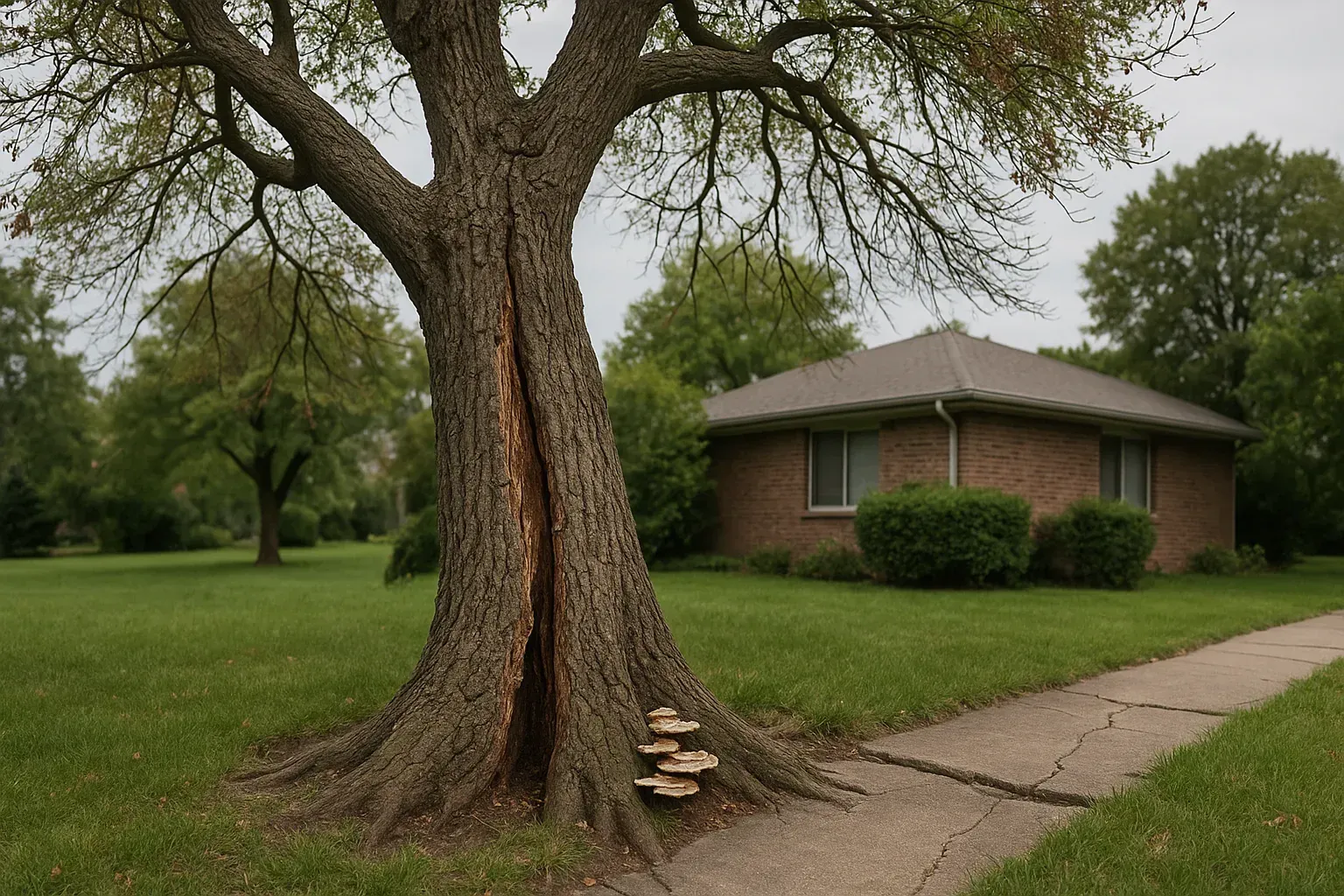While not every gnarled-looking tree needs the chop, some do. And the sooner you catch the signs, the more options you have (including ones that don’t involve removing it entirely).
From leaning trunks to mushrooms at the base, some tree issues are more than just cosmetic and can point to deeper problems with structure, safety, or compliance.
In this guide, we’ll walk through the most
common warning signs that a tree may be in trouble, and why getting a qualified opinion can save you time, money, and a whole lot of hassle down the track.
Quick Signs Your Tree Might Be in Trouble
Not sure if your tree’s just having a rough season or if it’s headed for removal? Here are a few red flags to look out for:
- Sparse or thinning canopy
- Cracks or splits in the trunk
- Sudden leaning or root movement
- Fungi growing at the base
- Hollow trunk or large cavities
- Interfering with buildings or services
- Unclear council protections
If any of these sound familiar, it’s worth digging deeper. Let’s break down what each sign actually means and what to do next.
1. Sparse or Patchy Canopy
A healthy tree should have a full, balanced canopy, especially during the growing season. If you notice your tree suddenly looks a bit... off (with fewer leaves, bare branches, or weird gaps), it’s often a sign something’s wrong beneath the surface.
Common causes include:
- Root damage from nearby construction or trenching
- Soil compaction, which prevents water and nutrients from getting to the roots
- Fungal infections, insect attacks, or nutrient deficiencies
These types of stress often affect the whole tree, starting from the ground up.
The good news?
Early intervention can sometimes save the tree. But without a proper diagnosis, you’re just guessing, and potentially missing a chance to restore it before removal becomes the only option.
2. Cracks or Splits in the Trunk
A vertical crack down the main trunk isn’t just an eyesore - it could be a warning sign. Cracks, splits, or even areas where the bark has peeled away may indicate:
- Past storm damage weakening the tree’s core
- Decay or rot spreading internally
- Structural stress where limbs or trunks are under too much tension
These structural weak points can make a tree particularly vulnerable during storms. Even moderate winds may cause it to fail if the internal stability has been compromised.
To get a clearer picture of what’s happening beneath the bark, professional arborists use tools like sonic tomography or resistograph testing.
These methods reveal internal decay or fractures that aren’t visible from the outside, helping determine whether the tree can be safely braced or pruned, or if removal is the safer option.
3. It’s Leaning (and It Didn’t Before)
A gradual lean that’s always been there? Probably nothing to worry about. But if your tree suddenly starts leaning more than it used to (or you notice soil cracking or heaving around the base), it’s worth getting checked.
Why? Because it may mean the root plate has shifted or lost anchorage, especially if the ground is waterlogged or the tree has shallow roots.
That puts it at risk of toppling.
We’ve seen this after heavy storms, rapid ground movement, or even nearby excavation works. A root investigation can help determine whether the anchorage has been compromised and what options are available.”
Acting quickly gives you more time to weigh options and avoid emergency removal after damage has already occurred.
4. Fungi Growing at the Base
Mushrooms popping up at the base of your tree may not seem like a big deal. But certain fungi (especially hard, shelf-like ones (called conks or brackets)) can signal internal decay in the heartwood or roots.
That’s because some fungi feed on the inner structure of the tree, hollowing it out over time while leaving the outside looking relatively normal.
Common fungal culprits include:
- Armillaria (honey fungus)
- Ganoderma (bracket fungus)
- Phellinus species
Spotting fungus doesn’t always mean the tree’s a goner. But it is a sign to get a professional opinion.
Arborists can tap the trunk, use decay detection tools, and check for other symptoms to work out what’s going on and whether the tree is safe to keep.
5. Hollow Trunk or Cavities
A hollow tree might sound like something out of a fairytale, but it’s actually quite common, especially in older trees. The tricky part is working out whether it’s a structural issue or just a quirky feature.
Some trees with large hollows are perfectly stable. Others are dangerously weak. It often depends on:
- The size of the hollow relative to the trunk diameter
- Where it’s located (at the base, midway up, etc.)
- Whether there’s visible movement when the tree sways in wind
According to the EPA NSW’s hollow-bearing tree guidelines, these cavities can also be ecologically valuable, so property owners are tasked with weighing safety against habitat value.
Alternatively. you can outsource this to professional arborists who use probes, decay sensors, or even advanced tools like sonic tomography to check how much solid wood remains.
If the structural integrity is too compromised, especially near people or property, removal may be the safest route.
6. It’s Interfering with Buildings or Services
Even a healthy, stable tree can become a problem if it’s in the wrong spot. In fact, one of the most common reasons for council-approved tree removals is location, not condition.
Trees may need to be removed if they’re:
- Growing into underground pipes or foundations
- Obstructing driveway visibility or street access
- Rubbing against buildings, fences, or rooflines
- Getting too close to power lines (which often involves utility provider intervention)
When this happens, councils often want proof that alternatives (like pruning or root barriers) have been considered.
In some cases, a
tree protection plan is required to show how vegetation will be retained or managed during nearby works.
Why You Shouldn’t DIY the Diagnosis
It’s tempting to play tree detective yourself, especially if the signs seem obvious. A cracked trunk? Must be unsafe. A bit of fungus? Time to cut it down, right?
Not always.
Tree health and safety isn’t something you can reliably judge from a quick once-over. Some trees with visible damage can be saved with pruning, cabling, or soil improvements.
Others that look perfectly healthy may be hiding internal decay or structural issues below the surface.
Here’s where DIY often goes wrong:
- Misreading the symptoms: For example, yellowing leaves could mean drought stress, root damage, or even herbicide drift from next door. Each one has a completely different solution.
- Overlooking council rules: You might think your tree’s on private land, so it’s your call. But many removals require permits, even for species you wouldn’t expect.
- Causing more damage: Well-meaning pruning can actually increase risk if cuts are made in the wrong places or at the wrong time of year.
- Risking personal safety: Assessing or removing a tree (especially a large one) without the right gear or training can be seriously dangerous.
Consulting arborists don’t just look at what’s obvious - they combine site conditions, species-specific knowledge, and formal assessment methods (like QTRA or TRAQ) to give a proper risk assessment.
That’s especially important if you’re dealing with council approvals, insurance claims, or construction projects.
The bottom line? Tree decisions can have long-term consequences for safety, liability, and property value. Getting it wrong could mean losing a tree that could’ve been saved, or worse, keeping one that should’ve been removed.
If you’re even a little unsure, it’s worth getting expert eyes on it. One good assessment now can save you from bigger problems down the track.
Unsure About a Tree on Your Property?
Don’t leave it to guesswork. Whether you’re dealing with a single backyard tree or a site full of vegetation, it pays to get expert advice before making any moves.
At TMC Reports, we help homeowners, developers, and councils make informed, defensible decisions with clear, council-ready arborist reports tailored to the situation. From risk assessments to permit support, we’ll guide you through the process with confidence.
Ready to work with TMC Reports?
Let's connect! We’re here to help.
Send us a message and we’ll be in touch.
Or give us a call today at 0401 442 604


